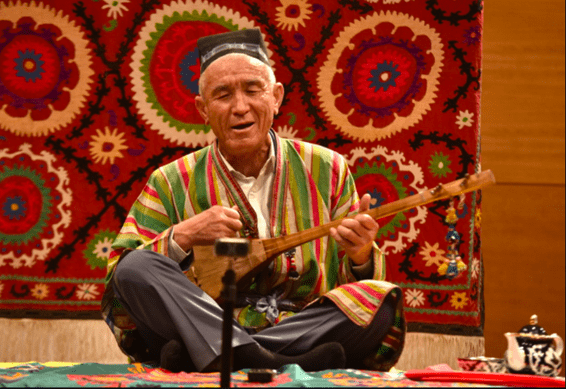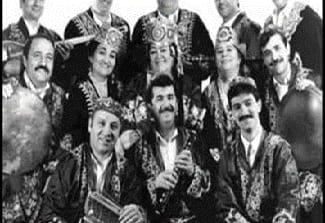In this section, you will learn about Uzbek pop stars as well as about a few kinds of Uzbek traditional music.
Modern Uzbek Pop Stars
DJ Piligrim
Perhaps, one of the best-known contemporary Uzbek musicians in the post-Soviet world is DJ Piligrim. He plays pop, dance, and house music and one can hear his songs at a party, club, and other social gatherings. He is on Spotify and Youtube. His song lyrics are often multilingual. You can hear him singing in Russian, Uzbek, English, Spanish, as well as trans-language across these languages. Check out some of his famous pieces below:
- https://www.youtube.com/watch?v=AHnXVN-x4zI&list=RDEMU6iVM8DAYILPcbVDmhG4OA&index=17
- https://www.youtube.com/watch?v=lFX5cB7PMww&list=RDEMU6iVM8DAYILPcbVDmhG4OA&start_radio=1
- https://www.youtube.com/watch?v=05ljE40OYhE&list=RDEMU6iVM8DAYILPcbVDmhG4OA&index=32
 Rap
Rap
Rap music became popular among the Uzbek youth in the 2000s. One of the pioneers of modern rap was Shoxrux. He appeared on the Uzbek music scene in the early 2000s and quickly achieved stardom. Another well-known Uzbek rapper is Shaxriyor, who has also starred in a number of movies since his music career has taken off. Common themes raised in this music genre in Uzbek are loyalty, friendship, patriotism, parental love, love, betrayal, and other moral issues that are central to Uzbek culture. To listen to some of these rap artists, follow the links below:
- Radius 21: https://www.youtube.com/watch?v=q2lMJtgL_ho
- Shoxrux: https://www.youtube.com/watch?v=J4M8Bj7PkJw&list=RDEM-1QxBpFMV3RJcMoxhzpCkg&start_radio=1 and https://www.youtube.com/watch?v=biO06gO76A8&list=RDEM-1QxBpFMV3RJcMoxhzpCkg&index=2
- Shaxriyor: https://www.youtube.com/watch?v=VO_ortAjuH4
Yulduz Turdieva
 The nation’s beloved contemporary singer Yulduz Turdieva was born in Bukhara, Uzbekistan. Singing primarily in Uzbek, Farsi, Tajik, and Azeri, she is famous for her vocals. She sings popular songs, but also is a skillful musician of a classic music of the region, maqom/maqam. Her fame spiked after a viral video in which she is singing with friends at a social gathering: https://www.youtube.com/watch?v=SOe62xYXTug
The nation’s beloved contemporary singer Yulduz Turdieva was born in Bukhara, Uzbekistan. Singing primarily in Uzbek, Farsi, Tajik, and Azeri, she is famous for her vocals. She sings popular songs, but also is a skillful musician of a classic music of the region, maqom/maqam. Her fame spiked after a viral video in which she is singing with friends at a social gathering: https://www.youtube.com/watch?v=SOe62xYXTug
Here are some of her other pieces:
- In Tajik: https://www.youtube.com/watch?v=TdQmUmSC-ag
- In Azeri: https://www.youtube.com/watch?v=TOD7ixo1wSA
- In Uzbek: https://www.youtube.com/watch?v=mSmcBALfPEQ
Yulduz Usmanova
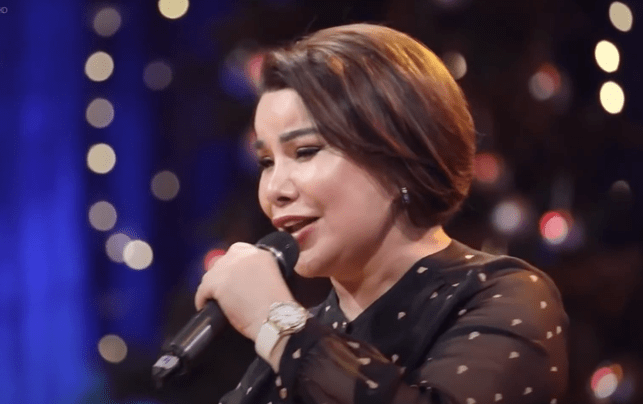 Yulduz Usmanova performing Keladi at a concert in early 2020
Yulduz Usmanova performing Keladi at a concert in early 2020
Yulduz Usmanova is a famous singer and actress originally from Margilan in Ferghana. The daughter of a silk factory worker, she studied at the State Conservatory of Uzbekistan. Her music became very famous in newly independent Uzbekistan after 1991 and became popular across Central Asia as well. In addition to her native Uzbek, she is also famous for singing in Tajik, Kazakh, Turkish, Tatar, Uyghur, Russian and Arabic.
Following these two links for an audio preview of two of her albums:
- Yoshligim, beboshligim (My youth, my uncontrollability), 2002
- Mendan meni surama (Don’t ask for me from me), 2003
Follow these links for a few of her music videos:
Traditional Uzbek Music
Traditional Singers – Bakhshi
The art of Bakhshi singing is a common Central Asian folklore music genre. Historical folk epics are usually performed by Bakhshis and transferred orally from generation to generation. It’s a difficult type of throat singing (overtone singing) genre and therefore not everyone can become a bakhshi. Their musical instruments vary depending on the locality. In Uzbekistan, bakshis use dombra and sometimes drums. Bakhshis in Uzbekistan have regional schools of art and differ from region to region in their style of singing and instruments. The historical folk epic Alpomish is the most popular epic among Uzbek bakhshis. It is a millennium old epic of the Central Asian Turkic peoples that reveals their common historical roots through the history of the Qungrat brothers. Traditional bakhshi schools are based on master-disciple relationships and they have continued the tradition over the centuries. Ergash Jumanbulbul and Shaberdi Bakhshi are popular representatives of the 20th century bakhshi school. Today, traditional bakhshi singing is still active at festivals and national holidays, especially in the Surkhondaryo and Qashqadaryo regions. Shaberdi bakhshi and Abdunazar bakhshi are well-known representatives of the Surkhan bakhshi school. In April 2019, Uzbekistan hosted the first international art festival in Termez, the historical capital city of Surkhondaryo.
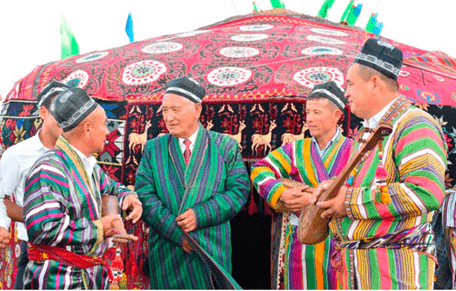 Bakshis in International festival April 2019 in Termiz
Bakshis in International festival April 2019 in Termiz
Here are some examples of bakhshi singing:
- Shoberdi bakhshi and Abdunazar bakhshi: https://www.youtube.com/watch?v=q9can5WWOqI
- The Alpomish epic sung by Shoberdi bakhshi: https://www.youtube.com/watch?v=2dF0gLGjx0Y
- A recent performance by Shoberdi bakhshi: https://www.youtube.com/watch?v=SSVr8yy0_z0
- A performance by Abdurokhmon bakhshi, one of Shoberdi bakhshi’s students: https://www.youtube.com/watch?v=e8jwuAXZ0fI
- A performance of “Malla Savdogar” (The Blond Merchant) by Abdunazar bakhshi: https://www.youtube.com/watch?v=QEjl3tEyVoo
Shashmaqam
Another classical Central Asian music genre is “Shashmaqam”, which is a Persian word meaning six modes. It is believed to have originated in the city of Bukhara and while played by a number of artists in Uzbekistan and Tajikistan, the most well-known musicians of shashmaqam are of Bukharian Jewish descent. Bukharian Jews also introduced this music genre to the West upon immigration to the United States.
Commonly used instruments in shashmaqam are a pair of long-necked lutes, a frame drum, which, with its jingles, is very much like a tambourine, and the tanbour, which vaguely resembles a bass fiddle. The languages of shashmaqam are Bukhori or Tajik or Uzbek. The lyrics are close to Sufi philosophy and ideas. It is vibrant and complex with male and female performances.
To learn more about shashmaqam follow the following links, from which you can gain much broader information on the origin, development, and dissemination of this music genre.
- Music and poetry of Central Asia Shashmqam: https://voicesoncentralasia.org/shashmaqam-music-and-poetry-of-central-asia/
- US-based Traditional Music and Dance: https://ctmd.org/programs/touring-artists/shashmaqam/
- Here is a wonderful performance on Youtube: https://www.youtube.com/watch?v=FKkJ_tciClc
Suggested Learning Activities
Here are two activities that can be completed either in a virtual classroom or as homework. Each student will learn about a different aspect of Uzbek classical music, so they will all have something important to contribute to the class.
Uzbek Traditional Instruments
- Go to this website about classic Uzbek music: http://www.classicmusic.uz/index.htm
- Click on the MUSIC INSTRUMENTS tab
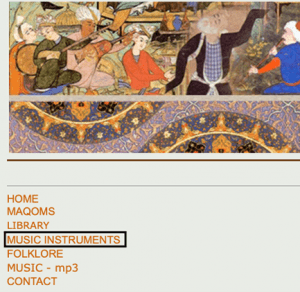
- On the next page pick one instrument to learn about. Choose between these instruments: Tanbur, Dutor, Rubob, Chang, Nay, Surnay, Qo’shnay, Chang-Qobuz

- After clicking on your instrument, click on the sound icon to listen to a recording!

- Write down your answers to these questions in complete sentences:
- What is your first response when you hear this instrument?
- What does it look like and what do you think it is made out of?
- Are there any American instruments (or instruments from your culture) that this instrument reminds you of?
- What role do you think this instrument would play in a musical ensemble?
- Share what you have learned with the rest of the class
Uzbek Traditional Music Artists
- Return to this website: http://www.classicmusic.uz/index.htm
- Click on the MUSIC – mp3 tab
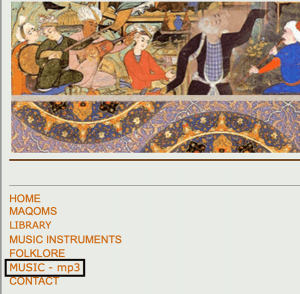
- On the next page pick one of the artists featured there
- Listen to their music and find your artist in the list of short biographies given below
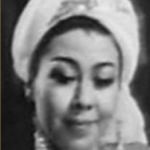

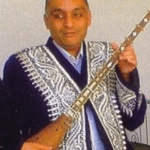


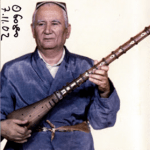


-
- Mehri Abdullaeva was born in 1931. She is a singer and actress in Uzbekistan and Tajikistan. She is known for her work at the Khamza theatre of Uzbek musical drama in Qo’qan.
- Gulsara G’oyibova currently lives in Tashkent and sings at many concerts throughout Uzbekistan. She sings in both Uzbek and Tajik. G’oyibova often performs songs based on classical poetry, for example, this poem by the Uzbek mystic poet Boborahim Mashrab (1653-1711).
- Farhod Qori Halimov was born in Samarqand in 1963. He was born partially blind and later became completely blind. He specializes in the maqam genre of singing and tanbur (long-necked lute) playing. After being a member of the Guldasta Instrumental Ensemble, he started his own traditional ensemble, which he still runs today. He often sings his own arrangements of classical texts in Tajik and Uzbek. The title “Qori” found in his name means Quran reciter.
- Hilola Hamidova was born in 1978 in the city of Andijan. In 1995, she began her musical education at the Andijan state school of art. After finishing her studies in Andijan, she enrolled in the maqam branch of the Tashkent state conservatory. After finishing conservatory, she joined the ensemble “Makom,” directed by Yunus Rajabiy. For a recent concert by this ensemble follow this link.
- Orifxon Hotamov was born in 1927 in Jizzakh. At the Tashkent Music education center (Toshkent musiqa bilim yurti), he specialized in the g’ijjak (a string instrument played with a bow and played by many different peoples across Central Asia). In the 1940s and 50s, he played in various national folk ensembles including the Uzbek State Philharmonic and the Uzbek Radio Folk Instrument Orchestra. Later in life he taught at the Mannon Uyg’ur State Art Institute and the Toshkent conservatory.
- Fattohxon Mamadaliev was born in Andijon in 1923. He graduated from the Andijan pedagogical institute in 1960. After leading various ensembles in Andijon, he joined the Uzbek National Philharmonic as a singer in 1983. The next year he began teaching at the Toshkent conservatory. Both his distinctive voice and his compositions are famous across Uzbekistan. He is also known for his work in the katta ashula genre.
- Ochilbek Matchonov is a popular singer and he usually plays the rubob while singing.
- Group MASHRIQ was founded in 2002 by Husniddin Atoyev. This group uses all of the instruments you learned about in the previous activity and they have toured extensively including concerts in Taiwan and the US. In 2013, they changed their name to OXUS after the Oxus river.
- Group NAVO features Abdufotih Teshaboyev on the nogora, Nodirbek Zokirov on the doira, Davron Ismatov on the surnay, Farhod Oripov, Rustam Khaitboyev, Utkur Jalolov and Botir Jamolov on the karnay. They perform both classical and modern compositions.
- Dilnura Qodirjonova was born in Andijon. In 1995, she came to Tashkent and started a dutor ensemble. She has also performed internationally and received numerous awards for her singing including the “Best Singer of Classical Songs in Uzbekistan” award, which she won in 2004 and 2005. Follow this link to listen to her performance of Yolg’iz Dog’man.
- The Ensemble SHUKRONA was founded in 2005 by Malika Ziyaeva. Shukrona means gratitude and this group specializes in dutor music. The dutor (Persian for “two strings”) is a two stringed lute-like instrument.
- Yulduz Turdiyeva was born in Bukhara in 1985. She graduated from the state conservatory of Uzbekistan in 2008. In 2009, she won first place at the Baynalxalq makom festival in Azerbaijan. Although she’s famous for her singing in Uzbek, Azeri, and Persian, she is still modest and in a recent interview she said that she is still learning and thinks of herself as a student.
- Jo’rahon Sultonov was born in 1903 in Marg’ilon in the Fergana region. He was a singer and a composer. His first music teacher was his father, but he was also taught by the legendary artists of the previous generation including Boltaboy Rajabov (1878-1960), Mamatbuva Hofiz Sattorov (1885-1969), Sodirxon Hofiz, and Mulla To’ychi Hofiz (1868-1943). He was recognized as a folk national singer in 1939. Many of his compositions put the works of classical poetry, including works by Navoiy and Furqat (1859-1909) and Chustiy, to music.
- Ensemble TAVOIS is an Uzbek classical music ensemble that performs with dancers. They also have worked closely with Dilnura Qodirjonova.
- Abror Zufarov specializes in the tanbur, sato and dutar instruments. He grew up in a musical family and his both his grandfather and his father made traditional instruments. He graduated from the State Conservatory of Uzbekistan in 1996 and joined the faculty at the conservatory. He performs a wide-reaching repertoire including works from both the Shashmaqom and the Fergana-Tashkent maqom traditions, as well as his own compositions. He is also conducting research on earlier versions of the scales used in maqom music.
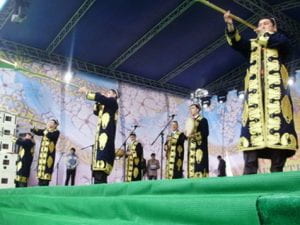
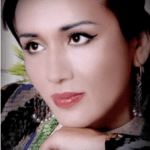

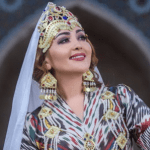
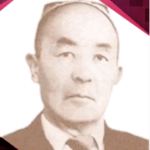


5. Write a short report about your artist or group and their music
6. Share your report with the rest of the class
Further Helpful Resources
- A Melody from Bukhara: https://www.youtube.com/watch?v=ZC2WPeZP_ZQ
- The Sogdiana Uzbek folk instruments chamber orchestra plays an arrangement of Uzbek folk songs “Melodies of Surkhan,” while social distancing. The first hashtag on the video “uyda qoling” means “please stay at home”: https://www.youtube.com/watch?v=Jht_de0gQQk
- A brief description of Uzbek instruments: https://globalconnect.uz/uzbekistan/culture/music
- A demonstration of different instruments by master Uzbek musician Mr. Vahoor: https://www.melodweb.com/index.php?act=search&yti=hWvF9PjkQ6U
- A film about Uzbek music: Music of the Uzbeks of Northern Afghanistan. 2013. Directed by Razia Sultanova and Usman Tufail. In Uzbek with English subtitles. Sponsored by the British Council. To obtain a copy, contact Razia Sultanova(rs588@cam.ac.uk).
- A Performance by the Music and Dance Ensemble Transoxania: https://www.youtube.com/watch?v=QJQVCnereAo
- A live performance by Yulduz Usmanova: https://www.youtube.com/watch?v=1TLyN35NktI
- A guide to the different lutes: https://shahnameh.netlify.app/sato.htm
- A book about women musicians: Tanya Merchant, Women Musicians of Uzbekistan: From Courtyard to Conservatory Urbana: University of Illinois Press, 2015.
- Some good information about the maqom genre: https://istanbultek.academia.edu/WilliamSumits
An Image of Traditional Notation from Khorezm
Image by Aleksandr Djumaev; Michael Church ed., The Other Classical Musics: Fifteen Great Traditions (Woodbridge: The Boydell Press, 2015), xiv, 351.


